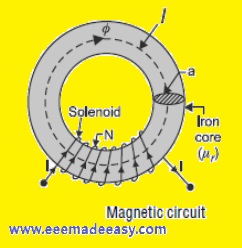Magnetic circuit: The closed path followed by magnetic flux is called a magnetic circuit.
Magnetic circuit
A magnetic circuit usually consists of magnetic materials having high permeability (e.g., iron,
soft steel, etc.).
In this circuit, magnetic flux starts from a point and finishes at the same point after completing its path.

The above Figure shows a solenoid having N turns wound on an iron core (ring). When current I ampere is passed through the solenoid, magnetic flux Φ Wb is set-up in the core.
Download & Install EEE Made Easy App
Let l = mean length of magnetic circuit in m;
a = area of cross-section of core in m2;
μr = relative permeability of core material.
Flux density in the core material, B = Φ/a Wb/m2
Magnetising force in the core material,H = B ÷ μ0μr = Φ ÷ aμ0μ AT/m
According to work law, the work done in moving a unit pole once round the magnetic circuit (or
path) is equal to the ampere-turns enclosed by the magnetic circuit.
i.e., Hl = NI or

The above expression reveals that the amount of flux set-up in the core is
(i) directly proportional to N and I i.e., NI, called magnetomotive force (mmf). It shows that the
flux increases if either of the two increases and vice-versa.
(ii) inversely proportional to l/a μ0 μr called reluctance of the magnetic path. In fact, reluctance is the opposition offered to the magnetic flux by the magnetic path.
The lower is the reluctance, the higher will be the flux and vice-versa.
Thus, Flux = m.m.f/reluctance
the above expression has a strong resemblance to Ohm’s law for electric current (I = emf/resistance).
The mmf is analogous to emf in electric circuit, reluctance is analogous to resistance and flux is analogous to current.
Because of this similarity, the above expression is sometimes referred to as Ohm’s law of magnetic circuits.
Important terms in magnetic circuits
While studying magnetic circuits, generally, we come across the following terms:
Magnetic field
The region around a magnet where its poles exhibit a force of attraction or
repulsion is called magnetic field.
Magnetic flux ()
The amount of magnetic lines of force set-up in a magnetic circuit is called
magnetic flux. Its unit is weber (Wb). It is analogous to electric current I in electric circuit.
The magnetic flux density at a point is the flux per unit area at right angles to the flux at that
point.
It is, generally, represented by letter ‘B’. Its unit is Wb/m2 or Tesla, i.e.,

Permeability
The ability of a material to conduct magnetic lines of force through it is called
the permeability of that material.
It is generally represented by μ (mu, a Greek letter).
The greater the permeability of a material,
the greater is its conductivity for the magnetic lines of force and vice-versa.
The permeability of air or vacuum is the poorest and is represented as μ0 (where μ0= 4π ×10–7 H/m).
Relative permeability
The absolute (or actual) permeability μ of a magnetic material is much greater than absolute permeability of air μ0.
The relative permeability of a magnetic material is given in comparison with air or vacuum.
Hence, the ratio of the permeability of material μ to the permeability of air or vacuum μ0 is
called the relative permeability μr of the material.
i.e., μr = μ/μ0
or μ = μ0 μr
Obviously, the relative permeability of air would be μ0/μ0 = 1.
The value of relative permeability of all the non-magnetic materials is also 1.
However, relative permeability value is as high as 8000 for soft iron,
whereas, its value for mumetal (iron 22% and nickel 78%) is as high as 1,20,000.
Magnetic field intensity
The force acting on a unit north pole (1 Wb) when placed at a point in the magnetic field is called the magnetic intensity of the field at that point.
It is denoted by H.
In magnetic circuits, it is defined as mmf per unit length of the magnetic path. It is denoted by
H, mathematically,

Magnetomotive force (mmf)
The magnetic pressure which sets-up or tends to set-up magnetic
flux in a magnetic circuit is called magnetomotive force. As per work law it may be defined as
under:
The work done in moving a unit magnetic pole (1 Wb) once round the magnetic circuit is called
magnetomotive force.
In general ,mmf = NI ampere-turns (or AT)
It is analogous to emf in an electric circuit.
Reluctance (S)
The opposition offered to the magnetic flux by a magnetic circuit is called its
reluctance.
It depends upon length (l), area of cross-section (a) and permeability (μ = μ0 μr) of the material
that makes up the magnetic circuit. It is measured in AT/Wb.

Permeance
It is a measure of the ease with which flux can be set-up in the material. It is just
reciprocal of reluctance of the material and is measured in Wb/AT or henry.

It is analogous to conductance in an electric circuit.
Reluctivity
It is specific reluctance and analogous to resistivity in electric circuit.
Join EEE Made Easy Telegram channel
More on Magnetic field
- 3 Effects of Electric Current|Magnetic Effect, Heating Effect & Chemical Effects
- Magnetic field MCQ|Magnetism MCQ Questions & Answers
- Magnetic data storage|Magnetic Bubble Memory, Magnetic Tapes, Magnetic Disks
- Magnetic materials: Dia, Para,Ferro,Ferri and Antiferro magnetic materials
- Magnetism-Methods of Magnetization
- What is magnetic field and its significance?|Magnetic Field
Latest Posts
Latest Posts in EEE Made Easy
- Environment MCQ for RRB JE CBT 2|Objective Questions Environment for Competitive Exams
- RRB JE CBT 2 Computer Awareness Book Arihant|Objective Computer Awareness Book 2025
- RRB JE CBT 2 Exam Date 2025 Postponed|RRB JE CBT 2 Exam Date
- [PDF]RRB JE Result 03/2024 Cut off, Selected no of candidates for all regions
- [PDF]Final Answer Key Junior Instructor Mechanic Agricultural Machinery|643/2023 Solved Question paper
- Acoustics MCQs|Industries Extension officer|IEO 2025
- LASER MCQs| Industries Extension officer|IEO 2025



